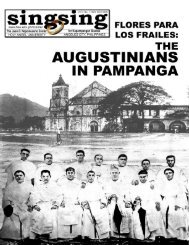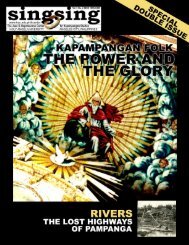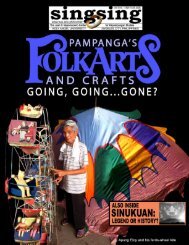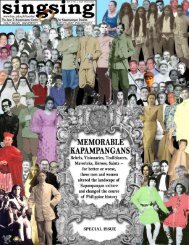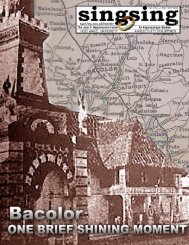Download PDF - Holy Angel University
Download PDF - Holy Angel University
Download PDF - Holy Angel University
You also want an ePaper? Increase the reach of your titles
YUMPU automatically turns print PDFs into web optimized ePapers that Google loves.
favored name of the new<br />
town was “<strong>Angel</strong>es” in<br />
honor of the “<strong>Holy</strong><br />
Guardian <strong>Angel</strong>s,” their<br />
patroness’ protectors. It<br />
is also in consideration of<br />
the Founder’s name Don<br />
<strong>Angel</strong> who put forward<br />
the new town under the<br />
love and care of Our Lady<br />
of the <strong>Holy</strong> Rosary whose<br />
feast day (La Naval) commemorates<br />
the beginning<br />
of its foundation.<br />
In the year 1833, the<br />
Founders built a new<br />
church replacing the old<br />
Santuario that was already<br />
inadequate in accommodating<br />
the inhabitants,<br />
who had multiplied<br />
progressively.<br />
In the same year, the<br />
Casa Tribunal was built,<br />
although since 1829<br />
(foundation date) there<br />
had already been a provi-<br />
sional one, having Don Ciriaco de Miranda,<br />
the Founder’s son, the first gobernadorcillo<br />
for the whole year of 1830. (The Casa Tribunal<br />
is the present municipal building.)<br />
From then on, the town of <strong>Angel</strong>es had<br />
been governed by gobernadorcillos for an<br />
annual term each until 1868 and later<br />
changed to two-year terms until 1893. Due<br />
to reforms in the Spanish administration,<br />
the title was changed to Capitan Municipal<br />
until 1898, towards the end of the Spanish<br />
regime in the Islands.<br />
At the time of <strong>Angel</strong>es foundation,<br />
there were only six barrios: Sto. Rosario<br />
(the center), San Jose, Cutcut, Pampang,<br />
Amsic and Santol which were successively<br />
populated from 1796, when the founders<br />
settled down in Culiat. The founders donated<br />
to the Church two parts of the land,<br />
one dedicated to the parish priest’s main-<br />
The original processional<br />
image of the town’s patron<br />
saint enshrined at the <strong>Holy</strong><br />
<strong>Angel</strong> <strong>University</strong> chapel<br />
(Courtesy of Mrs. Teresita N.<br />
Wilkerson)<br />
Descendants of Don <strong>Angel</strong> Pantaleon de Miranda (Sally Naguiat)<br />
tenance, and the other to<br />
finance the annual fiesta<br />
celebration.<br />
In 1846, Capitan General<br />
Claveria was appointed<br />
to Pampanga; he<br />
ordered that San<br />
Fernando’s seven barrios<br />
become part of <strong>Angel</strong>es.<br />
They are Pulungbulo,<br />
Mining, Tabun, Capaya,<br />
Sapa Libutad, Pulung<br />
Cacutud, and Pandan.<br />
Likewise, the three barrios<br />
of Mabalacat:<br />
Malabañas, Balibago and<br />
Pulung Maragul, and a<br />
barrio of Mexico: Cutud.<br />
That shaped the expanse<br />
of <strong>Angel</strong>es town with the<br />
boundaries of the three<br />
towns. Aside from the 17<br />
barrios mentioned, <strong>Angel</strong>es<br />
stretched out to other<br />
areas mainly due to the<br />
population increase that<br />
extended to other five<br />
villages, which were not yet populated.<br />
They are the following: Sto. Domingo in<br />
1830, Anunas in 1840, Sto. Cristo in 1852<br />
and San Nicolas in 1852. Areas which<br />
started to be populated when the market<br />
was relocated to the site at that time were<br />
Tacondo that comprised the barrio of<br />
Anunas, and began to be inhabited in 1890;<br />
Sapangbato of barrio Pasbul Bulo in 1898,<br />
and Talimunduc of barrio San Nicolas in<br />
1901. In summary, <strong>Angel</strong>es had 22 barrios<br />
at that time, and three places identified<br />
also to become barrios….<br />
Even before being constituted as a<br />
town, a Santuario had been built in Culiat<br />
in 1810 but it was only two years later<br />
(1812) that it had its first chaplain, Padre<br />
Juan Zablan, a native of Minalin,<br />
Pampanga, and later followed by Padre De<br />
Concepcion, Pedro David, Vicente Navarro,<br />
Cristobal Concepcion, Flaviano Ladia,<br />
Agapito Medina, Claudio de Castro, Leandro<br />
Cortes, Jose de la Incarnacion and Macario<br />
Paras, who were all Pampangos.<br />
Culiat was the name of the barrio of<br />
San Fernando that became the town of <strong>Angel</strong>es.<br />
It is the name of a bush that then<br />
grew there in abundance. But the other<br />
barrios like Santol and Anunas are names<br />
taken from fruit-bearing trees; Pandan,<br />
name of a very well known plant; Tabun,<br />
which means dam or dike; Pampang, high<br />
borders of a river or tideland;<br />
Pulongmaragul, large forest; Pulung<br />
Cacutud, small forest; Pulungbulu and<br />
Pasbulbulo, places where there are an<br />
abundance of bamboos and canes;<br />
Sapalibutad, means to be in between or in<br />
an estuary or creek; Capaya, name of a<br />
plant called papaya; Balibago, shrub/tree<br />
of fibrous bark; and Sapangbatu, a brook<br />
that runs among rocks.<br />
<strong>Angel</strong>es, when constituted as a town<br />
(1829), stopped being administered by religious<br />
chaplains. The last one noted was Don<br />
Macario Paras. Parish priests succeeded<br />
them and the first Augustinian friars were<br />
as follows: Vicente Cordones, Manuel Diaz,<br />
Pedro Medina, Jose M. Torres, Tomas Oresa,<br />
Guillermo Masnou, Ramon Sarronandia, Juan<br />
Marino, Pedro Ibeas, Vicente Ruiz, Rufino<br />
Santos, and Baltazar Camarra, the last Spanish<br />
priest; and later, the Filipino seculars,<br />
Don Vicente Lapus and Don Pablo Gamboa,<br />
the current parish priest.<br />
This results in a summary of all data<br />
that I acquired at the time. And as seen,<br />
<strong>Angel</strong>es being a newly founded town, lacks<br />
legends and old manuscripts except those<br />
provided to me by Don Mariano V. Henson,<br />
one of the surviving grandsons of the<br />
founders.<br />
(Translated from the Spanish<br />
original by Anton Prima)<br />
21



